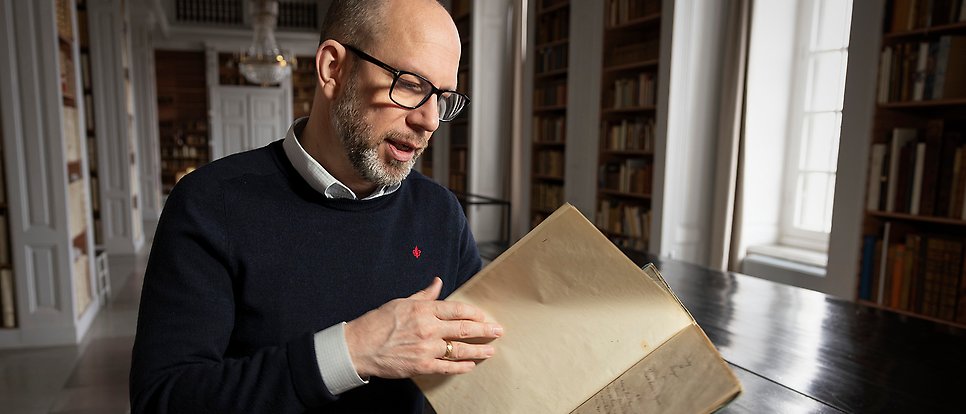Uppsala Student Union was formed out of emerging political consciousness

Johan Sjöberg, Archivist at the University Library, shows the original statutes of the Uppsala Student Union from 1849. Photo: Mikael Wallerstedt.
Sweden’s oldest student union is about to celebrate its 175th anniversary. The Uppsala Student Union was founded in 1849 in part because the students had a growing need to take a collective political stand. There was a need for an organisation that could speak on behalf of students on various current issues.
Uppsala Student Union was founded on 11 March 1849 jointly by the thirteen student nations in Uppsala. It was a time when students were becoming more and more politically engaged. Those with liberal views saw nations as outdated and old-fashioned.
Please also read the news item Uppsala Student Union to celebrate its 175th anniversary.
The question of whether and how students should organise themselves was discussed by students around the world at the time. It was an era of voluntary organisations, something which was also reflected at the universities.
“In Uppsala, many students felt that the nations were an obstacle to the formation of a joint student association.”
Need to express political views
“A need emerged for students to express political views. This need was present in all political camps, both liberal and conservative. But there was a problem. There was no organisation that could speak for the students because it was difficult to get the nations to unite,” explains Johan Sjöberg, Archivist at the University Library and PhD-holder in history.
Sjöberg has conducted research on student politics in Uppsala during the 18th and 19th centuries.
From the 1830s, and particularly during the 1840s, students began to perform together at various events related to activities such as choral singing or student Scandinavianism. On the first 1 May event, a nationwide student carnival also marched to Eklundshof.
“During the carnivals, people dressed up and commented on various current issues. A common issue was whether or not to keep the Riksdag of the Estates. They could also present sketches from the local area, but often in a jocular manner. There was also propaganda for a joint student union.”
An important part of the joint university events was the Spring Festival in the Botanical Garden. Important speeches were given there to kick off the spring festivities. For example, it was at the Spring Festival in 1925 that the then Uppsala student Karin Boye gave her Speech for the man.
It was traditional to give a “speech for the woman” at the Spring Festival, so the Student Union Board proposed for the Spring Festival in 1924 that a similar speech be given for the man.
Compromise between political views
In the 1840s, newspapers began to both report and interpret what was happening in the student world. However, there were different images of student life depending on the political colour of the newspaper. The pressure to take a political stand was thus increased both by the students themselves and by external factors.
“Students could no longer hide behind half-hearted songs. They had to take a stand or clearly not take a stand.”
In 1846, the Student Association, a voluntary organisation
and a kind of precursor to the student union, was established. However, it became problematic with a lot of fighting between the nations and the Student Association.
“To put it simply, Uppsala Student Union emerged as a compromise between conservative students, who defended the nations, and liberals, who supported the Student Association. There was a need for an organisation that could speak on behalf of students on various current issues. The compromise meant that the nations together constituted the Student Union and the curators and elected members constituted the union leadership.
Uppsala model established
Students elected members to the council of the Student Union via thirteen constituencies. The constituencies corresponded to the thirteen nations. The students thus belonged to a nation and elected the nation's representatives to the Student Union’s council.
By the early 1960s, the University was growing and many students wanted elections with party lists. However, many also wanted to keep the 13 nations as constituencies. The equation was a difficult one and, after trying different electoral systems, the current system of one constituency and party elections was introduced.
What is known as the “Uppsala model” had thus been established, whereby the Uppsala Student Union was responsible for monitoring studies and the student nations for social aspects.
“In this context, it’s important to remember that as the Uppsala Student Union was developing in the mid-19th century, the student nations began to change. The nations were reformed into more modern institutions in parallel with the development of the Uppsala Student Union.”
Anders Berndt
Active members of Uppsala Student Union who became widely known
- Gösta Knutsson, President of the Union 1936–1938.
- Tage Danielsson, Vice President of the Union in 1955.
- Birgitta Kettner, later Dahl. Active in the early 1960s.
- Anna-Greta Leijon, active in the early 1960s.
